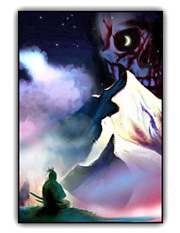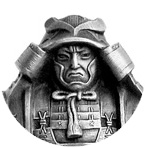YAMAMOTO TSUNETOMO: HIDDEN BY THE LEAVES
-

There is surely nothing other than the single purpose of the present moment. A man’s whole life is a succession of moment after moment. If one fully understands the present moment, there will be nothing else to do, and nothing else to pursue. Live being true to the single purpose of the moment.
When one understands this settling into single-mindedness well, his affairs will thin out. Loyalty is also contained within this singlemindedness.
― Yamamoto TsunetomoYamamoto Tsunetomo (山本 常朝), also known as Yamamoto Jōchō (1659–1719), was a Japanese samurai of the Saga domain under his lord Mitsushige Nabeshima. Since childhood, he served the clan and lived as a samurai, and that was enough for him. He liked the honest relations between the warriors, their plain lifestyle. All that was asked of them was to be loyal, stand up, and die when necessary. Being ready to die felt natural, like a pure spring sunrise.
Over years of service a young samurai and daimyo created a friendship that gave him joy and allowed him to attain a high place. Archery and sword practice were his primary activities. Over time, he came to understand his master’s teaching; that both archery and the art of the sword essentially teach about life. Only one thing that grieved him. The nation had been peaceful for over a century and life flowed like water, but the samurai wanted to be killed in action, youthful and strong. The years passed, but there was still no opportunity for his dream to come true. An unheroic death would humiliate him. He had been cherishing his sword hoping to fulfill his duty: to follow his lord in death by committing seppuku. He fantasized about a proud and glorious warrior’s death, his chance to say farewell with his own blood.
Yamamoto Tsunetomo by Tatiana Berg | Purchase print or painting | All Artwork
A little before the daymyo’s death, however, something surprising happened. Concerned about multiple ritual samurai suicides following the deaths of their lords, the shogun issued a decree banning it under penalty of lasting shame and exile. Tsunetomo accepted this, but renounced the world and lived his remaining years in a hut praying for the repose of his lord’s soul.
Some of his thoughts came to be known under the title Hidden by the Leaves; they were written down by his disciple Tashiro Tsuramoto.
Above all, the Way of the Samurai should be in being aware that you do not know what is going to happen next, and in querying every item day and night. Victory and defeat are matters of the temporary force of circumstances. The way of avoiding shame is different. It is simply in death.
Even if it seems certain that you will lose, retaliate. Neither wisdom nor technique has a place in this. A real man does not think of victory or defeat. He plunges recklessly towards an irrational death. By doing this, you will awaken from your dreams.
― Yamamoto Tsunetomo“Hagakure more or less disappeared from view following Yamamoto’s death in 1719. Manuscript copies were retained and studied by the Nabeshima clan in Saga Han, but the work was not published. No doubt the emphasis on loyalty to one’s immediate lord would not have gone down well with the centralising government of the shogunate.
The work came to public knowledge following the Meiji Restoration in 1868, and was published in the early twentieth century, towards the end of the Meiji period. In the 1930s it was reinterpreted: loyalty to the daimyo was replaced by loyalty to the emperor. It became a standard text in the thoroughly militarised society of mid-twentieth century Japan. Kamikaze pilots often went into action wearing headbands which bore slogans from Hagakure.
After the defeat of Japan and the American occupation, Hagakure was a text to be avoided. It was seen as promoting the values which had led Japan to start the Pacific War.” (Martin Jenkins, Yamamoto Tsunetomo (1659–1719), 2019)
Samurai Guards (tattoo design) by Tatiana Berg | Purchase print or painting | All ArtworkWhatever you do should be done for the sake of your Master, Parents, the people in general, and for posterity. This is Great Compassion. The wisdom and courage that come from compassion are real wisdom and courage. When one punishes or strives with the heart of compassion, what he does will be limitless in strength and correctness. Doing something only for one’s own sake is shallow and mean and turns into evil. I understood the matters of wisdom and courage some time ago. I am just now beginning to understand the matter of compassion.
― Yamamoto TsunetomoHagakure tells us about bushido and samurai life, describes the principles of the bushi class. The books is based on the author’s experience – he had served the Nabeshima clan for 30 years; the book contains many stories and quotes by the members of this clan. Yamamoto Tsunetomo also comments on certain historic events and legends, e.g. the revenge of the 47 ronin.
Tsunetomo held sacred the idea that reconciliation with the idea of death helps a person to transcend our plane of being and find the beauty and perfection beyond the reach of other people.
The ability to follow the Way until his dying day is a great quality of a warrior.According to the Hagakure, a samurai suffering from a fatal condition involving pyrexia was feverish on his deathbed and going in and out of consciousness. Seeing his condition, a thief mustered the courage to steal something from him. However, the samurai managed to harness his last effort of will to draw his sword and stab him as he took his last breath. Such great willpower persisting to the very end represents true samurai spirit. In another example, Yamamoto Tsunetomo writes about a samurai who was able to strike while his head had already been severed. Even a dead samurai can commit one last act by using up all his willpower. As the Hagakure’s author contests, “If a distinguished warrior is full of determination, he can be likened to a vengeful spirit. He does not die at once even when his head is cut off.”
Hidden By The Leaves is Yamamoto Tsunetomo’s famous book. The name is symbolic, for it truthfully expresses the true essence of Bushido; things that are hidden from laymen’s sight – the true teaching of warriors. Only those who contemplate the depths of the teaching and who implement it start seeing the flowers hidden behind the “leaves” of the mundane. Every day brings new a dimension: fresh, beautiful flowers inspiring a warrior’s love. If those who follow the way enrich themselves with knowledge, if their way flows like a stream, it means that they have entered the gates and have found themselves within its mandala.Hidden By The Leaves is a noble book
The wise Samurai chose a fitting name –
‘Eternal Morning,
A True Friend’…
Comprises Tsunetomo.
Yamamoto simply means –
‘The foot of the mountain’…
― A. R. Berg, Legend
This article contains quotes from the Samurai Series.
Read more about Yamamoto Tsunetomo in the Samurai Book SeriesBack to the Blog

